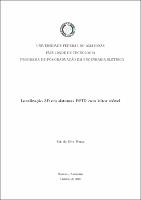| ???jsp.display-item.social.title??? |


|
Please use this identifier to cite or link to this item:
https://tede.ufam.edu.br/handle/tede/6866Full metadata record
| DC Field | Value | Language |
|---|---|---|
| dc.creator | Ferraz, Eric da Silva | - |
| dc.creator.Lattes | http://lattes.cnpq.br/3778918607727525 | por |
| dc.contributor.advisor1 | Carvalho, Celso Barbosa | - |
| dc.contributor.advisor1Lattes | http://lattes.cnpq.br/8269546823033896 | por |
| dc.contributor.referee1 | Cavalcante, André Luiz Duarte | - |
| dc.contributor.referee1Lattes | http://lattes.cnpq.br/4129171042070633 | por |
| dc.contributor.referee2 | Mota, Edjair de Souza | - |
| dc.contributor.referee2Lattes | http://lattes.cnpq.br/5771638576099195 | por |
| dc.date.issued | 2018-10-19 | - |
| dc.identifier.citation | FERRAZ, Eric da Silva. Localização 3D em sistemas RFID com leitor móvel. 2018. 74 f. Dissertação (Mestrado em Engenharia Elétrica), Universidade Federal do Amazonas, Manaus, 2018. | por |
| dc.identifier.uri | https://tede.ufam.edu.br/handle/tede/6866 | - |
| dc.description.resumo | Mecanismos para localização de objetos utilizando o sinal de RSSI(Received Signal Strength Indication) de etiquetas RFID(Radio Frequency Identification) tem sido bastante explorados, na grande maioria no plano bidimensional (2D), poucos são os trabalhos de localização tridimensional (3D). Neste trabalho adotamos uma matriz de etiquetas de referência reais (passivas) e etiquetas virtuais (etiquetas que não existem fisicamente). Adotamos um único leitor RFID móvel, desta forma reduzimos os custos de implementação do sistema. A mobilidade do leitor possibilita que este se movimente em todas as direções e consiga efetuar leituras em diferentes posições. Ao final das leituras o algoritmo proposto avalia a diferença entre o RSSI da etiqueta alvo e os RSSI das etiquetas da matriz de referência, buscando similaridades entre seus valores, retornando possíveis posições da etiqueta alvo (posições de etiquetas da matriz de referência que tem o RSSI com um valor de diferença entre zero até "x"dB quando comparados ao RSSI da etiqueta alvo). Em seguida o algoritmo avalia a diferença entre as coordenadas x, y e z das possíveis posições, identificando qual o eixo tem a maior diferença e efetua uma nova leitura movendo-se no eixo de maior diferença. Após esta nova leitura, a posição da etiqueta de referência com o RSSI mais próximo ao RSSI da etiqueta alvo é selecionada como posição estimada pelo sistema. Os experimentos realizados utilizando o ambiente simulado, demonstraram que a proposta obteve uma maior precisão, quando comparado com outros trabalhos (ganho de 46% comparando-se o Erro da solução proposta com o Erro de outras soluções). | por |
| dc.description.abstract | In this work we adopt an matrix of real reference tags (passive) and virtual tags (tags that do not exist physically). We use a single mobile RFID reader, in order to reduce the implementation costs. The mobility of the reader allows it to move in all directions and to be able to read in different positions. At the end of the readings the proposed algorithm evaluates the difference between the RSSI of the target tag and the RSSI of the reference matrix tags, looking for similarities between their values, returning possible positions of the target tag (tags positions of the reference matrix wich has the RSSI with a difference value between zero to "x" dB when compared to RSSI of the target tag). Then the algorithm evaluates the difference between the coordinates x, y, and z of the possible positions, identifying which axis has the largest difference. After that perform a new reading by moving the reader on the axis of greatest difference. The position of the reference tag with the RSSI closest to the RSSI of the target tag in this new reading is selected as the position estimated by the system. Experiments using the simulated environment demonstrated that the proposal was more accurate when compared to other studies (gain of 46% comparing the Error of the proposed solution with the Error of other solutions). | eng |
| dc.format | application/pdf | * |
| dc.thumbnail.url | https://tede.ufam.edu.br//retrieve/27155/Disserta%c3%a7%c3%a3o_EricFerraz_PPGEE.pdf.jpg | * |
| dc.language | por | por |
| dc.publisher | Universidade Federal do Amazonas | por |
| dc.publisher.department | Faculdade de Tecnologia | por |
| dc.publisher.country | Brasil | por |
| dc.publisher.initials | UFAM | por |
| dc.publisher.program | Programa de Pós-graduação em Engenharia Elétrica | por |
| dc.rights | Acesso Aberto | por |
| dc.rights.uri | http://creativecommons.org/licenses/by/4.0/ | - |
| dc.subject | RSSI | por |
| dc.subject | RFID | por |
| dc.subject | Localicazação tridimensional | por |
| dc.subject | Leitor móvel | por |
| dc.subject | Three-dimensional location | eng |
| dc.subject | Mobile reader | eng |
| dc.subject | Average error | eng |
| dc.subject | Erro médio | por |
| dc.subject.cnpq | ENGENHARIAS: ENGENHARIA ELÉTRICA: TELECOMUNICAÇÕES: RADIONAVEGAÇÃO E RADIOASTRONOMIA | por |
| dc.subject.cnpq | ENGENHARIAS: ENGENHARIA ELÉTRICA: TELECOMUNICAÇÕES: SISTEMAS DE TELECOMUNICAÇÕES | por |
| dc.title | Localização 3D em sistemas RFID com leitor móvel | por |
| dc.title.alternative | 3D localization in RFID systems with mobile reader | eng |
| dc.type | Dissertação | por |
| Appears in Collections: | Mestrado em Engenharia Elétrica | |
Files in This Item:
| File | Description | Size | Format | |
|---|---|---|---|---|
| Dissertação_EricFerraz_PPGEE.pdf | 1.48 MB | Adobe PDF |  Download/Open Preview |
This item is licensed under a Creative Commons License





